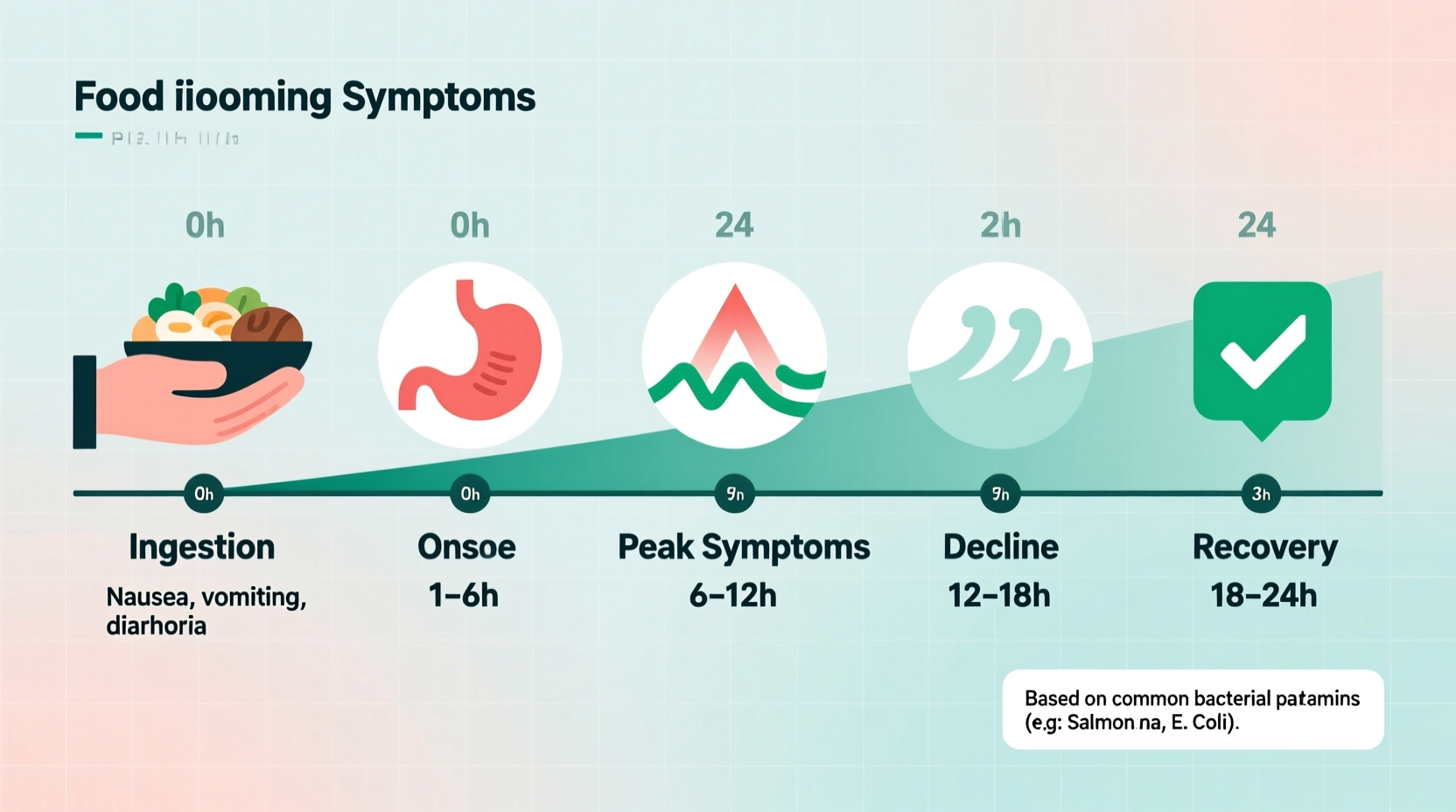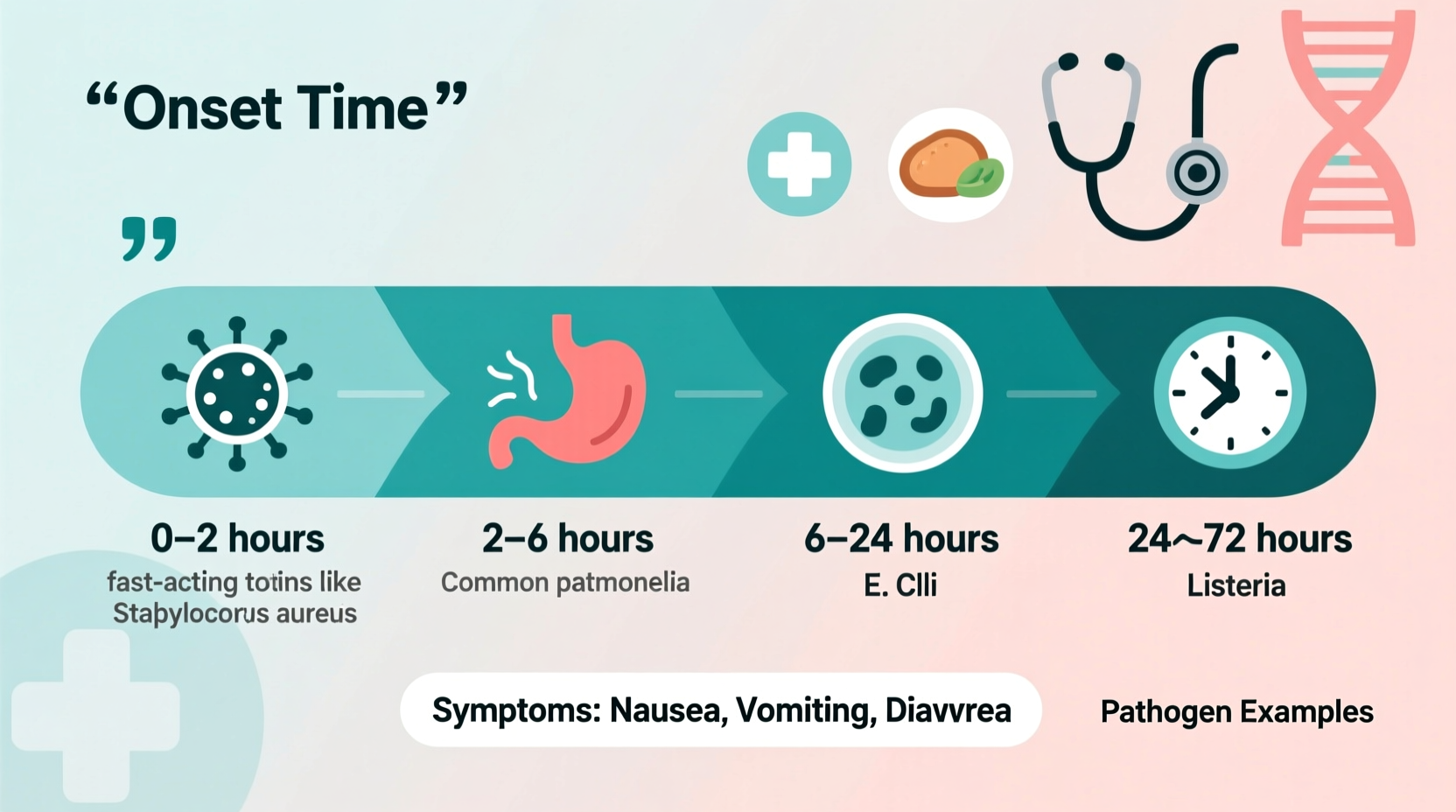Understanding when food poisoning symptoms might strike after eating is crucial for proper response and treatment. If you've recently consumed potentially contaminated food, knowing what to expect can help you determine whether to monitor symptoms at home or seek immediate medical attention.
Why Food Poisoning Onset Times Vary
The time between eating contaminated food and experiencing symptoms—known as the incubation period—depends primarily on the specific pathogen responsible. Different bacteria, viruses, and toxins multiply at varying rates in your digestive system before reaching levels that cause noticeable illness.
According to the Centers for Disease Control and Prevention (CDC), over 250 different foodborne diseases exist, each with its own characteristic incubation period. Your age, immune status, and the quantity of contaminated food consumed also influence when symptoms appear.
| Pathogen | Typical Onset Time | Common Sources |
|---|---|---|
| Staphylococcus aureus | 30 minutes - 8 hours | Deli meats, salads, cream-filled pastries |
| Bacillus cereus (vomiting type) | 1-6 hours | Fried rice, other cooked starches |
| Salmonella | 6-48 hours | Raw eggs, poultry, unpasteurized milk |
| Escherichia coli (E. coli) | 1-10 days | Undercooked ground beef, raw produce |
| Listeria | 1-4 weeks | Soft cheeses, deli meats, smoked seafood |
| Campylobacter | 2-5 days | Raw poultry, unpasteurized milk |
| Hepatitis A | 15-50 days | Contaminated water, shellfish |
This comprehensive CDC data shows why it's challenging to pinpoint exactly when food poisoning will occur after eating. The FDA Food Code identifies specific pathogens and their characteristics to help food service professionals prevent contamination.
What Happens During the Incubation Period
After consuming contaminated food, pathogens begin multiplying in your digestive tract. During this silent period:
- Bacteria like Salmonella or E. coli attach to intestinal walls and multiply
- Some pathogens produce toxins that irritate your digestive system
- Your immune system starts recognizing the invaders and mounting a defense
- Fluid shifts occur as your body tries to flush out the contaminants
Most people don't experience any symptoms during this incubation phase, which is why pinpointing the exact meal that caused illness can be difficult—especially when symptoms appear days later.

When Symptoms Appear Within Hours
If symptoms strike within 1-8 hours after eating, you've likely consumed food contaminated with pre-formed toxins. These rapid-onset illnesses include:
- Staphylococcal food poisoning: Caused by toxins from Staphylococcus aureus bacteria, often found in foods left at room temperature like potato salad or cream-filled pastries
- Bacillus cereus (vomiting type): Commonly associated with improperly stored rice dishes
- Chemical contaminants: Such as cleaning agents accidentally introduced to food
The World Health Organization notes that these rapid-onset illnesses typically cause vomiting as the primary symptom, with diarrhea being less common. The short incubation period occurs because you're reacting to toxins already present in the food, rather than waiting for bacteria to multiply in your system.
Delayed Onset Food Poisoning: When Symptoms Take Days
Many serious foodborne illnesses have longer incubation periods. If symptoms appear 2-14 days after eating, you may have:
- Salmonella infection: Often from raw eggs or undercooked poultry
- Campylobacteriosis: Typically from raw or undercooked poultry
- Listeriosis: Particularly dangerous for pregnant women and immunocompromised individuals
- Hepatitis A: Can cause illness weeks after exposure
The CDC specifically warns that Listeria can take up to 70 days to cause symptoms, making it exceptionally difficult to trace back to the contaminated food source. This extended incubation period is why health officials sometimes struggle to identify the source of widespread outbreaks.
What to Do While Waiting for Symptoms
If you know you've consumed potentially contaminated food but haven't developed symptoms yet:
- Don't induce vomiting - This can cause additional complications
- Stay hydrated with small sips of clear fluids
- Preserve evidence - Keep any remaining suspect food for potential testing
- Monitor high-risk individuals more closely (infants, elderly, pregnant women, immunocompromised)
- Don't take anti-diarrheal medications preemptively as they can prolong infection
Mayo Clinic experts recommend having oral rehydration solutions on hand if you're at risk, as these can help maintain electrolyte balance if symptoms develop. Remember that the absence of immediate symptoms doesn't mean you're in the clear—some pathogens take days to manifest.
When to Seek Medical Attention Immediately
Consult a healthcare provider if you experience:
- Symptoms lasting more than 3 days without improvement
- Signs of dehydration (dry mouth, little or no urination, dizziness)
- High fever (over 101.5°F or 38.6°C)
- Bloody stools or vomit
- Neurological symptoms like blurred vision or muscle weakness
- Symptoms after consuming high-risk foods like wild mushrooms or pufferfish
Pregnant women who suspect Listeria exposure should seek medical care immediately, even before symptoms appear, as early treatment can prevent transmission to the fetus. The American College of Gastroenterology emphasizes that timely medical intervention can prevent complications in severe foodborne illness cases.
Preventing Food Poisoning: Key Strategies
Understanding how long after eating food poisoning occurs highlights the importance of prevention. Follow these evidence-based practices:
- Chill promptly: Refrigerate perishables within 2 hours (1 hour if above 90°F/32°C)
- Cook thoroughly: Use a food thermometer to ensure meats reach safe internal temperatures
- Prevent cross-contamination: Use separate cutting boards for raw meats and produce
- Wash hands properly: For at least 20 seconds with soap and warm water before handling food
- Be cautious with high-risk foods: Raw shellfish, unpasteurized dairy, and undercooked eggs
The FDA Food Code establishes specific temperature guidelines to prevent bacterial growth. Remember that proper food handling eliminates the need to wonder how long after eating food poisoning will occur, as you'll significantly reduce your risk of exposure.
Recovering After Food Poisoning
Once symptoms begin, focus on recovery:
- Start with the BRAT diet (bananas, rice, applesauce, toast) as symptoms improve
- Avoid dairy, caffeine, alcohol, and fatty foods until fully recovered
- Gradually reintroduce solid foods as tolerated
- Continue hydration efforts even after symptoms subside
- Wash hands frequently to prevent spreading illness to others
Most healthy adults recover from food poisoning without complications within 1-3 days. However, some pathogens like Campylobacter can trigger Guillain-Barré syndrome in rare cases, highlighting why monitoring symptoms beyond the initial illness is important.











 浙公网安备
33010002000092号
浙公网安备
33010002000092号 浙B2-20120091-4
浙B2-20120091-4